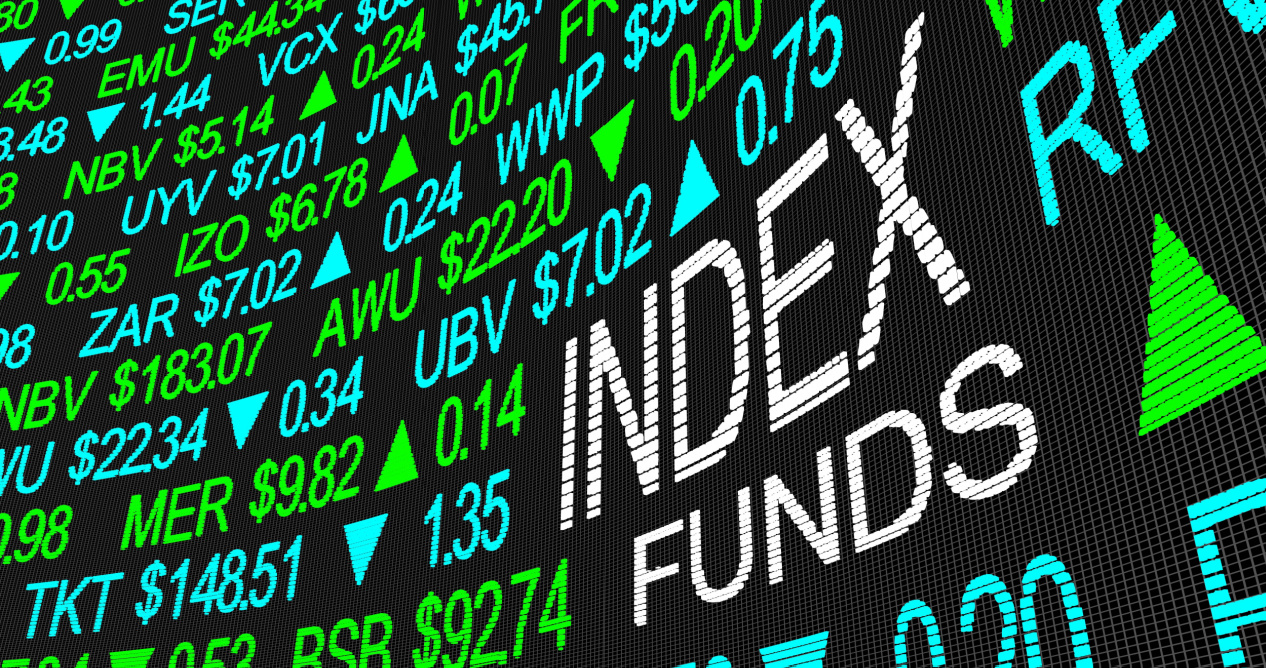In this article, we’ll take a deep dive into index funds: what they are, how they work, and everything in between.

What are Index Funds?
Index funds are a type of publicly traded investment fund — a kind of basket of different stocks or bonds designed to follow the performance of a specific index.
For example, an S&P 500 index fund invests in the 500 largest U.S. companies to mirror the performance of the S&P 500 index.
Instead of picking individual stocks, you’re buying a tiny piece of all these companies in one go. The idea is to diversify your investments, reducing the risk that comes with investing in single stocks.
Short History of Index Funds
Index funds were introduced in the 1970s by John Bogle, the founder of Vanguard Group. Bogle aimed to create a low-cost investment option that would track the performance of a specific market index, such as the S&P 500.
His idea was to provide investors with a simple, diversified portfolio that would consistently mirror the overall market’s performance.
Bogle launched the First Index Investment Trust (now known as the Vanguard 500 Index Fund) in 1976, making it the first index fund available to individual investors.
Over time, index funds gained popularity due to their low fees, tax efficiency, and ability to outperform actively managed funds.
Today, index funds have become a cornerstone of many investment portfolios, offering investors a passive and low-cost way to participate in the stock market.
How Do Index Funds Work?
Index funds work by replicating the performance of a specific market index, like the S&P 500, which is made up of 500 of the largest publicly traded U.S. companies.
So, when you invest in an index fund, you’re essentially buying a small piece of all the stocks or bonds in that index. The fund does this by using the money it gets from investors to buy all the stocks or bonds in the same proportion as they exist in the index.
This way, the performance of the index fund should very closely match the performance of the index it’s tracking.
What’s cool about this is that you’re diversifying your investment. Instead of having all your eggs in one or two baskets (like if you just bought individual stocks), you’re spreading it out over many baskets. That way, if one company’s stock drops, it’s not a disaster because you’re invested in many other companies too.
Why Choose Index Funds
While there are several PROs and CONs of Index funds, their low fees, strong performance, and tax efficiency make them a popular option among all investors. Here’s an overview of these key aspects:
Low Fees
Index funds typically have lower expense ratios compared to actively managed funds. Expense ratios represent the annual fees charged by the fund provider for managing the fund. Since index funds aim to replicate the performance of a specific market index rather than relying on active stock selection, they have lower operating costs. These lower fees make index funds an attractive option for investors seeking cost-efficient investment vehicles.
It’s true that actively managed and passively managed fees have both been dropping over recent years; Morningstar notes that the average fee for a passively managed fund is just 0.12%, compared to 0.60% for an actively managed funds.

Performance
Over the long term, index funds have demonstrated competitive performance compared to many actively managed funds.
By closely tracking a specific market index, index funds aim to deliver returns in line with the overall performance of the market or sector they represent. Actively managed funds, on the other hand, aim to outperform the market but often struggle to consistently do so. Couple this with the low fees of index funds contribute to their ability to provide competitive net returns to investors.
Tax Efficiency
As investing giant Vanguard points out, index funds tend to be more tax-efficient compared to actively managed funds.
Due to their low turnover, index funds generate fewer taxable events like capital gains distributions.
Actively managed funds may incur higher turnover and capital gains due to the frequent buying and selling of securities, potentially resulting in increased tax liabilities for investors. Index funds, with their buy-and-hold approach and minimal trading, reduce the likelihood of triggering taxable events, making them more tax-efficient.
It’s important to note that while index funds offer advantages in terms of low fees, performance, and tax efficiency, individual fund selection is crucial. Factors such as tracking error, fund size, and provider reputation should be considered when choosing specific index funds.
Additionally, investors should evaluate their investment goals, risk tolerance, and time horizon to determine the most suitable index funds for their portfolios. Consulting with a financial advisor or conducting thorough research can help in making informed investment decisions.
How To Buy Index Funds
Buying index funds is straightforward and generally involves a few simple steps:
1. Open a brokerage account
You’ll need an account with an online brokerage firm to buy index funds.
Some popular ones include Webull, eToro, and M1 Finance, but there are many to choose from depending on the types of features you are looking for.
2. Choose the Index Fund
Once you have your account opened, you’ll need to pick which index fund you want to buy.
Look for a fund that tracks an index you’re interested in, like the S&P 500 or the Dow Jones Industrial Average.
3. Buy the Fund
After you’ve picked your index fund, you can buy shares directly through your online brokerage account.
You can do this as a one-time purchase, set up regular investments, or even purchase fractional shares.
Types of Index Funds
There are several types of index funds that represent different sectors or parts of the market.
Below are a few examples:
1. Stock or Equity Index Funds
These funds track a specific stock index like the S&P 500 (U.S. large-cap stocks), the Nasdaq Composite (largely technology-related stocks), or the Russell 2000 (U.S. small-cap stocks).
Stock index funds like VOO and SPY, which track the S&P 500, are among the more popular index funds. Many investors also like VTI instead of VOO because VTI covers the entire investable stock market.
- SPDR S&P 500 ETF Trust (SPY): This is one of the most widely traded securities in the world. It tracks the S&P 500 Index, which is composed of the 500 largest companies in the U.S.
- Vanguard Total Stock Market ETF (VTI): This ETF aims to track the CRSP US Total Market Index, which includes virtually all U.S.-listed stocks.
- Invesco QQQ Trust (QQQ): This ETF tracks the Nasdaq-100 Index, which includes 100 of the largest domestic and international non-financial companies listed on the Nasdaq Stock Market based on market capitalization.
2. Bond Index Funds
These funds track indexes of various types of bonds, like government bonds, corporate bonds, or municipal bonds.
Some popular bond index funds include:
- Vanguard Total Bond Market Index Fund: Seeks to track the performance of the Bloomberg Barclays U.S. Aggregate Float Adjusted Index, which represents the U.S. investment-grade bond market.
- iShares Core U.S. Aggregate Bond ETF: Aims to replicate the performance of the Bloomberg Barclays U.S. Aggregate Bond Index, which includes a wide range of investment-grade U.S. bonds.
- Schwab U.S. Aggregate Bond ETF: Seeks to track the performance of the Bloomberg Barclays U.S. Aggregate Bond Index, providing exposure to a diversified portfolio of U.S. investment-grade bonds.
These funds offer investors a way to gain broad exposure to the bond market and can be suitable for those seeking fixed-income investments in their portfolios.
It’s always advisable to conduct further research and consider your investment goals and risk tolerance before making investment decisions.
3. Sector Index Funds
These focus on specific sectors of the economy, such as technology, healthcare, or financials. An example would be a fund that tracks the Information Technology sector of the S&P 500.
Sector Index funds may be a good option for investors who think a certain sector may benefit from certain macro trends. But remember, sector-specific ETFs can be more volatile than broader market ETFs, as they are more sensitive to the performance of their respective sectors. Always research thoroughly or consult a financial advisor before investing.
- Technology Select Sector SPDR Fund (XLK): This ETF tracks the performance of public companies in the technology sector, as defined by the Global Industry Classification Standard (GICS). The fund includes companies from technology hardware, storage, and peripherals; software; communications equipment; semiconductors and semiconductor equipment; IT services; and electronic equipment, instruments, and components.
- Health Care Select Sector SPDR Fund (XLV): This ETF tracks the performance of public companies in the healthcare sector, as defined by the GICS. It includes companies from health care providers and services; health care equipment and supplies; biotechnology; pharmaceuticals; and life sciences tools and services.
- Financial Select Sector SPDR Fund (XLF): This ETF tracks the performance of public companies in the financial sector, as defined by the GICS. It includes companies from diversified financial services; insurance; banks; capital markets; mortgage real estate investment trusts (REITs); consumer finance; and thrifts and mortgage finance.
4. International Index Funds
These funds track non-U.S. markets. Some may focus on developed markets, emerging markets, or specific regions or countries.
- iShares MSCI EAFE ETF (EFA): This ETF follows the MSCI EAFE Index, which includes companies from Europe, Australasia, and the Far East (hence the name EAFE). It is one of the most popular funds for investors seeking broad exposure to developed markets outside of North America.
- Vanguard FTSE Developed Markets ETF (VEA): This fund tracks the performance of the FTSE Developed All Cap ex US Index. This includes companies from Canada and other developed countries, excluding the United States.
- iShares MSCI Emerging Markets ETF (EEM): EEM tracks the MSCI Emerging Markets Index, providing broad exposure to emerging market equities, such as China, South Korea, Taiwan, and others.
5. Commodity Index Funds
These funds track the price of commodities, like gold, oil, or a diversified group of commodities.
- Invesco DB Commodity Index Tracking Fund (DBC): This fund offers exposure to a broad range of commodities, including energy, precious metals, and agricultural goods, through futures contracts.
- United States Commodity Index Fund (USCI): USCI is a broad commodity index ETF that seeks to avoid contango, a situation where futures prices are higher than spot prices, which can negatively affect returns.
- iShares S&P GSCI Commodity-Indexed Trust (GSG): This fund aims to track the S&P GSCI Total Return Index, offering broad exposure to commodities through futures contracts.
6. Real Estate Index Funds
These funds track indexes related to real estate, often through Real Estate Investment Trusts (REITs).
Each type of index fund has its own risk and return characteristics, so it’s important to consider how they fit into your overall investment strategy and goals.
- Vanguard Real Estate ETF (VNQ): This ETF seeks to track the performance of the MSCI US Investable Market Real Estate 25/50 Index, which includes a variety of REITs involved in residential, office, retail, and other types of properties.
- iShares U.S. Real Estate ETF (IYR): IYR aims to track the performance of the Dow Jones U.S. Real Estate Index. This ETF includes a variety of REITs that span residential, commercial, and other sectors
- Schwab U.S. REIT ETF (SCHH): SCHH follows the Dow Jones U.S. Select REIT Index, which also includes a diverse range of REITs.
Who Should Invest In Index Funds?
Index funds can be a good fit for a wide variety of investors due to their simplicity, broad diversification, and generally lower costs compared to actively managed funds.
Here are a few types of investors who might find index funds appealing:
Beginner Investors
If you’re learning how to become an investor, index funds can be a great way to dip your toes in the water. They give you exposure to a wide swath of the market without requiring you to pick individual stocks or bonds.
Long-Term Investors
Index funds are often used for long-term goals like retirement savings. Since they’re designed to match the market’s performance, they tend to be a “buy and hold” type of investment.
Cost-Conscious Investors
If you’re mindful of fees (which can eat into your returns over time), you’ll appreciate that index funds generally have lower expense ratios than actively managed funds.
Risk-Averse Investors
While all investing involves risk, index funds spread that risk across many different stocks or bonds.
This diversification can help smooth out the bumps when certain sectors or companies take a hit.
The basic rule of thumb is to hold X number of stocks to eliminate concentration risk.
Hands-Off Investors
If you prefer a “set it and forget it” approach, index funds could be a good fit. Once you’ve bought into the fund, you don’t need to actively manage your investments.
Remember, though, that everyone’s financial situation and goals are unique. It’s always a good idea to research your options or consult with a financial advisor before making investment decisions.
Common Mistakes to Avoid
While investing in index funds seems like a no-brainer, there are common mistakes you should attempt to avoid
1. Chasing Performance
One common mistake is chasing performance by investing in index funds that have recently outperformed others. It’s tempting to believe that past winners will continue to excel, but this approach can be counterproductive.
Performance can be cyclical, and funds that have outperformed in the short term may not sustain their success in the long run.
Instead, focus on the underlying principles, diversification, and long-term performance of the index fund.
2. Overtrading
Overtrading refers to the frequent buying and selling of index funds based on short-term market movements or emotions.
This mistake can lead to higher transaction costs and undermine the benefits of low-cost index funds.
Trying to time the market consistently is challenging, if not impossible. Instead, maintain a disciplined approach and stick to your long-term investment strategy. Avoid making impulsive decisions based on market fluctuations.
3. Neglecting Portfolio Rebalancing
Portfolio rebalancing involves periodically reviewing and adjusting your investment allocations to maintain the desired asset allocation. Neglecting this crucial step can result in an unbalanced portfolio that deviates from your intended risk profile.
Over time, certain index funds may outperform or underperform, altering your asset allocation. Regularly rebalancing ensures that your portfolio remains aligned with your investment goals and risk tolerance.
Frequently Asked Questions
How Many Index Funds Should I Own?
The number of index funds to own can depend on a few factors, like your investment goals, risk tolerance, and desired level of diversification. Owning multiple index funds can help you spread your investments across different types of assets (like stocks, bonds, and real estate) and different geographic areas (like U.S., international, or emerging markets).
That said, you can achieve a good level of diversification with just a few broadly diversified index funds.
For example, you might choose one fund that tracks a broad U.S. stock index, another that tracks an international stock index, and a third that tracks a bond index.
However, the “right” number can vary depending on your personal situation and it’s a good idea to consult with a financial advisor or do your own research to figure out the best approach for you.
Also, it’s important to remember that investing always comes with risks and it’s important to understand these before making investment decisions.
How are Index Funds Taxed?
Index funds, like other investments, are subject to taxes on any dividends and capital gains they generate.
Here’s a simple breakdown:
Dividends
If your index fund pays out dividends, you’ll owe taxes on those dividends in the year they’re received. These could be taxed at your ordinary income tax rate or at the lower “qualified” dividend rate, depending on how long the fund held the underlying stocks.
Capital Gains
There are two types of capital gains – short-term and long-term. If you sell your fund shares within a year, any gain is considered short-term and is taxed at your ordinary income tax rate. But if you hold onto your shares for longer than a year, any gain becomes long-term and is generally taxed at a lower rate.
One thing to note – index funds are generally pretty tax-efficient because they don’t trade in and out of stocks as much as actively managed funds, so they don’t generate as many capital gains.
And don’t forget, if you hold your index funds in a tax-advantaged account like a 401(k) or an IRA, you can often defer or avoid some of these taxes.
As always, tax rules can be complex and can change from year to year, so it’s a good idea to consult with a tax advisor to fully understand your personal tax situation
The Bottom Line
Index funds are a popular investment option that aims to track the performance of a specific market index, such as the S&P 500.
They offer a passive and low-cost approach to investing, making them accessible to individual investors. Index funds provide instant diversification by holding a broad range of securities within the index they track, reducing risk.
Over the long term, index funds have consistently shown the ability to match or outperform actively managed funds, primarily due to their low fees and broad market exposure.
They have become a reliable and convenient tool for investors looking for a straightforward way to participate in the stock market and achieve steady, long-term returns.



